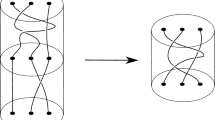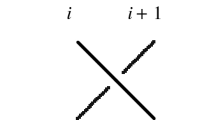Abstract
In recent years, various cryptographic protocols using infinite non-commutative groups, notably braid groups, have been proposed. Both experimental and theoretical evidence collected so far, however, makes it appear likely that braid groups are not a good choice for the platform. In this paper, we thus consider to use affine braid groups, a natural generalization of braid groups, as a platform. Like braid groups, affine braid groups have a very nice geometrical interpretation and have several properties that make them acceptable for cryptographic purposes. On the other hand, there are also essential differences between their structures; for example, unlike braid groups, affine braid groups have no Garside structure, which makes the conjugacy problem in these groups more difficult. We examine the feature that makes affine braid groups useful to cryptography and then conclude that this class of groups could provide a promising alternative platform for group-based cryptography.
Similar content being viewed by others
Explore related subjects
Discover the latest articles, news and stories from top researchers in related subjects.References
Allcock D.: Braid pictures for Artin groups. Trans. Am. Math. Soc. 354(9), 3455–3474 (2002)
Anshel, I., Anshel, M., Fisher, B., Goldfeld, D.: New key agreement protocols in braid group cryptography. In: Proceedings of 2001 Conference Topics in Cryptology: Crypt. Track RSA. Lect. Notes Comput. Sci. 2020, 13–27 (2001)
Anshel I., Anshel M., Goldfeld D.: An algebraic method for public-key cryptography. Math. Res. Lett. 6, 287–292 (1999)
Baumslag G., Fine B., Xu X.: Cryptosystems using linear groups. Appl. Algebra Eng. Commun. Comput. 17, 205–217 (2006)
Bessis D.: The dual braid monoid. Ann. Sci. Ecole Norm. Sup. 36(5), 647–683 (2003)
Bigelow S.: Braid groups are linear. J. Am. Math. Soc. 14, 471–486 (2001)
Birman J., Gebhardt V., González-Meneses J.: Conjugacy in Garside groups I: cyclings, powers, and rigidity. Groups Geom. Dyn. 1, 221–279 (2007)
Birman J., Gebhardt V., González-Meneses J.: Conjugacy in Garside groups III: periodic braids. J. Algebra 316(2), 746–776 (2007)
Birman J., Gebhardt V., González-Meneses J.: Conjugacy in Garside groups II: structure of the ultra summit set. Groups Geom. Dynam. 2(1), 16–31 (2008)
Birman J., Ko K., Lee S.: A new approach to the word and conjugacy problems in the braid groups. Adv. Math. 139(2), 322–353 (1998)
Brieskorn E.: Die Fundamentalgruppe des Raumes der regulären Orbits einer endlichen komplexen Spiegelungsgruppe. Invent. Math. 12, 57–61 (1971)
Brieskorn E., Saito K.: Artin-gruppen und Coxeter-gruppen. Invent. Math. 17, 245–271 (1972)
Budney R.: On the image of the Lawrence-Krammer representation. J. Knot Theory Ramif. 14(6), 1–17 (2005)
Cao, Z.F., Dong, X.L., Wang, L.C.: New public key cryptosystems using polynomials over non-commutative rings. Preprint, p. 35. http://eprint.iacr.org/2007/009 (2007)
Charney R.: Artin groups of finite type are biautomatic. Math. Ann. 292(4), 671–683 (1992)
Charney R., Peifer D.: The K(π, 1)-conjecture for the affine braid groups. Comment. Math. Helv. 78(3), 584–600 (2003)
Cheon, J., Jun, B.: A Polynomial Time Algorithm for the Braid Diffie-Hellman Conjugacy Problem. In: CRYPTO 2003. Lect Notes Comput. Sci. 2729, 212–225 (2003)
Cohen A.M., Wales D.B.: Linearity of Artin groups of finite type. Israel J. Math. 131, 101–123 (2002)
Collins D.: Relations among the squares of the generators of the braid group. Invent. Math. 117(1), 525–529 (1994)
Crisp, J.: Injective maps between Artin groups. In: Geometrical Group Theory Down Under, Proceedings of Special Year Geometric Group Theory, pp. 119–137. Canberra, Australia (1996)
Dehornoy P.: A fast method for comparing braids. Adv. Math. 125(2), 200–235 (1997)
Dehornoy P.: Braid-based cryptography. Contemp. Math. 360, 5–33 (2004)
Dehornoy, P., Dynnikov, I., Rolfsen, D., Wiest, B.: Ordering Braids. Math. Surv. Monogr. 148, Am. Math. Soc. (2008)
Dehornoy P., Paris L.: Gaussian groups and garside groups, two generalizations of artin groups. Proc. London Math. Soc. 79(3), 569–604 (1999)
Deligne P.: Les immeubles des groupes de tresses généralisés. Invent. Math. 17, 273–302 (1972)
Digne F.: On the linearity of Artin braid groups. J. Algebra 268(1), 39–57 (2003)
Digne F.: Présentations duales des groupes de tresses de type affine Ã. Commun. Math. Helv. 81(1), 23–47 (2006)
Dynnikov, I.A.: On a Yang-Baxter mapping and the Dehornoy ordering. Uspekhi Mat. Nauk 57(3), 151–152 (2002) (Russian); English Translation in Russ. Math. Surv. 57(3), 592–594 (2002)
Eick, B., Kahrobaei, D.: Polycyclic Groups: A New Platform for Cryptology? Preprint, p. 7. http://arxiv.org/abs/math/0411077 (2004)
El-Rifai E., Morton H.: Algorithms for positive braids. Quart. J. Math. 45(4), 479–497 (1994)
Epstein D.B.A., Paterson M.S., Camon G.W., Holt D.F., Levy S.V., Thurston W.P.: Word Processing in Groups. Jones and Bartlett Publishers, Boston, MA, USA (1992)
Franco N.: Conjugacy problem for subgroups with applications to Artin groups and braid type group. Commun. Algebra 34(11), 4207–4215 (2006)
Franco N., González-Meneses J.: Conjugacy problem for braid groups and Garside groups. J. Algebra 266(1), 112–132 (2003)
Garber D.: Braid group cryptography. In: Berrick, J., Cohen, F.R., Hanbury, E. (eds.) Braids: Introductory Lectures on Braids, Configurations and Their Applications, pp. 329–403. World Scientific, Singapore (2009)
Garber D., Kaplan S., Teicher M., Tsaban B., Vishne U.: Probabilistic solutions of equations in the braid group. Adv. Appl. Math. 35, 323–334 (2005)
Garber D., Kaplan S., Teicher M., Tsaban B., Vishne U.: Length-based conjugacy search in the braid group. Contemp. Math. 418, 75–87 (2006)
Garside F.: The braid group and other groups. Quart. J. Math. 20(1), 235–254 (1969)
Gebhardt V.: A new approach to the conjugacy problem in Garside groups. J. Algebra 292(1), 282–302 (2005)
Gebhardt V., González-Meneses J.: The cyclic sliding operation in Garside groups. Math. Z. 265(1), 85–114 (2010)
Gersten S., Short H.: Rational subgroups of biautomatic groups. Ann. Math. 134(1), 125–158 (1991)
Gersten S., Short H.: Small cancellation theory and automatic groups: part II. Invent. Math. 105(1), 641–662 (1991)
Hofheinz D., Steinwandt R.: A practical attack on some braid group based cryptographic primitives. Lect. Notes Comput. Sci. 2567, 187–198 (2002)
Hughes J.: A linear algebraic attack on the AAFG1 braid group cryptosystem. Lect. Notes Comput. Sci. 2384, 176–189 (2002)
Hughes, J., Tannenbaum, A.: Length-based attacks for certain group based encryption rewriting systems. In: SÉcurité des Communications sur Internet (SECI02), Hôtel El Mechtel. Tunis, Tunisie, pp. 5–12 (2002)
Humphreys J.: Reflection Groups and Coxeter Groups. Cambridge University Press, Cambridge (1990)
Johnson D., Albar M.: The centre of the circular braid group. Math. Japon. 30, 641–645 (1985)
Kalka A.: Representation attacks on the braid Diffie-Hellman public key encryption. Appl. Algebra Eng. Commun. Comput. 17(3), 257–266 (2006)
Kapovich I., Myasnikov A., Schupp P., Shpilrain V.: Generic-case complexity, decision problems in group theory, and random walks. J. Algebra 264(2), 665–694 (2003)
Kent IV R., Peifer D.: A geometric and algebraic description of annular braid groups. Int. J. Algebra Comput. 12, 85–97 (2002)
Ko K., Lee S., Cheon J., Han J., Kang J., Park C.: New public-key cryptosystem using braid groups. CRYPTO 2000, Lect. Notes Comput. Sci. 1880, 166–183 (2000)
Krammer D.: Braid groups are linear. Ann. Math. 155(1), 131–156 (2002)
Labruere C.: Generalized braid groups and mapping class groups. J. Knot Theory Ramif. 6(5), 715–726 (1997)
Lee E., Lee S.: Abelian subgroups of Garside groups. Commun. Algebra 36(3), 1121–1139 (2008)
McCammond, J.: Dual euclidean Artin groups and the failure of the lattice property. Preprint, p. 40. http://www.math.ucsb.edu/~mccammon/papers/lattice-failure.pdf (2011)
Myasnikov A., Shpilrain V., Ushakov A.: Random subgroups of braid groups: an approach to cryptanalysis of a braid group based cryptographic protocol. Lect. Notes Comput. Sci. 3958, 302–314 (2006)
Myasnikov A., Shpilrain V., Ushakov A.: Group-based Cryptography. Birkhäuser Verlag, Springer, Berlin (2008)
Myasnikov, A., Ushakov, A.: Length based attack and braid groups: Cryptanalysis of Anshel-Anshel-Goldfeld key exchange protocol. In: Public Key Cryptography PKC 2007. Lect. Notes Comput. Sci. 4450, 76–88 (2007)
Paris L.: Braid groups and Artin groups. In: Papadopoulus, A. (ed.) Handbook of Teichmüller Theory, vol 2, EMS Publishing House, Zurich (2008)
Picantin M.: Explicit presentations for the dual braid monoids. C. R. Acad. Sci. Paris, Ser. I 334, 843–848 (2002)
Ram, A., Ramagge, J.: Affine Hecke algebras, cyclotomic Hecke algebras and Clifford theory. A Tribute to CS Seshadri: A Collection of Articles on Geometry and Representation Theory (2003)
Shpilrain V., Ushakov A.: Thompson’s group and public key cryptography. Lect. Notes Comput. Sci. 3531, 151–163 (2005)
Sibert H., Dehornoy P., Girault M.: Entity authentication schemes using braid word reduction. Discrete Appl. Math. 154(2), 420–436 (2006)
Sidelnikov V., Cherepnev M., Yaschenko V.: Systems of open distribution of keys on the basis of noncommutative semigroups. Russ. Acad. Sci. Dokl. Math. 48(2), 384–386 (1994)
Tits J.: Normalisateurs de tores I Groupes de Coxeteretendus. J. Algebra 4(1), 96–116 (1966)
Vershik A., Nechaev S., Bikbov R.: Statistical properties of braid groups with application to braid groups and growth of heaps. Commun. Math. Phys. 212, 469–501 (2000)
Wagner, N., Magyarik, M.: A public key cryptosystem based on the word problem. In: CRYPTO 1984. Lect. Notes Comput. Sci. 196, 19–36 (1985)
Wang L.C., Wang L.H., Cao Z.F., Yang Y.X., Niu X.X.: Conjugate adjoining problem in braid groups and new design of braid-based signatures. Sci. China Inform. Sci. 53, 524–536 (2010)
Zheng, H.: General cycling operations in Garside groups. Preprint, p. 22. http://arxiv.org/abs/math/0605741 (2006)
Author information
Authors and Affiliations
Corresponding author
Rights and permissions
About this article
Cite this article
Zhu, P., Wen, Q. Affine braid groups: a better platform than braid groups for cryptology?. AAECC 22, 375–391 (2011). https://doi.org/10.1007/s00200-011-0157-1
Received:
Revised:
Accepted:
Published:
Issue Date:
DOI: https://doi.org/10.1007/s00200-011-0157-1




